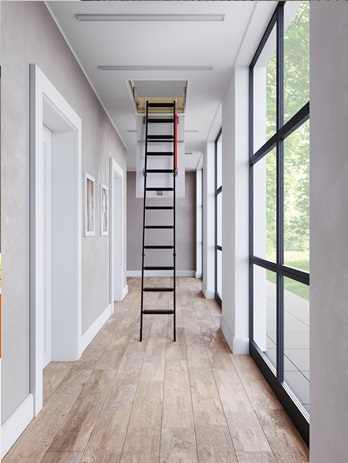Loft ladders are an essential accessory if you have an attic. They provide a quick and easy way to access the space on the top floor. It is also important that such a route up the stairs is safe. That’s why they should have a few essential features to make it easier to use the extra space in the house. So what are the points to bear in mind?

Loft Ladder Size
Choosing the right size of a ladder is the first and crucial step to think about when planning your project. There are several important factors to consider to ensure that the staircase fits the opening, the room, and is comfortable to use.
Size of the Opening
Loft ladder sizes are varied, and choosing the right one depends mainly on the size of the opening into which it will be fitted. The most important aspect in choosing the size of the staircase is therefore the size of the opening through which the staircase will be placed. Loft ladders are minimally smaller than the dimensions shown on the label to ensure adequate installation clearance.
Room Height
Another important factor is the height of the room, indicated by the ‘H’ symbol. Loft ladders are available in two heights as standard: 280 cm and 305 cm. The room height should be measured from the finished floor to the ceiling. If the height is lower than the standard height of the loft ladder, it may need to be adjusted by trimming. For very tall rooms, it is possible to use extension feet to adjust the height of the stairs.
Sweeping Distance
For small rooms or corridors, the sweeping distance, denoted by the letter “R”, also plays an important role. It determines how much space is needed to freely extend the stair ladder. It is worth paying attention to this issue, especially when space is limited, to ensure that they can be used comfortably.
Loft Ladder Insulation
According to the NIA organisation, on average as much as 25% of all heat loss in a house is related to the loft. It is therefore very important to insulate your ladder. For this reason, look for a staircase that is energy efficient, so that you can reduce your energy consumption as much as possible. To achieve this, the hatch should be fully insulated with a low U-value. In addition, it is best if there is a seal around the hatch.
The thickness of the hatch, which can range from 3.6 to even 8 cm – depending on the model – will also be of considerable importance in this case. Obviously, thicker flaps will be more energy-efficient, which is particularly important in the case of an uninsulated loft.
Ease of Installation
The other important point to consider is their ease of installation. It is a good idea to choose models that are simple and intuitive to install, especially if you intend to install them yourself. When selecting a ladder make sure that the producer provides a complete installation kit and clear instructions that will make the whole installation process easier.
In addition, it is also worth checking whether the producer offers technical support or assistance in case of installation difficulties. This will help avoid unnecessary complications and nerves, and you can quickly enjoy your new loft ladder that will ensure not only safety but also comfort.
Safety in Use
The safety of the loft ladder is extremely important and can be ensured primarily by the non-slip treads, which increase safety, especially when the stairs are used by people wearing shoes (especially women in stilettos) or small children. Thanks to the proper finish of the steps, the risk of slipping is minimised.
The resistance to weight pressure is also important in this respect. Loft ladders should be designed to withstand quite a lot of weight – after all, we often carry heavy boxes of stuff into the loft. So it’s worth paying attention to the maximum allowable weight pressure to avoid damage or worse, an accident.
Finally, don’t forget about structural stability. Make sure the stairs are stable and solidly constructed. The structure should be durable and the connecting parts (e.g. hinges) should fit well. Regular inspection and maintenance will help keep them safe for longer.
Wood or Metal Loft Ladder?
The final point to be made is undoubtedly the material from of which the stairs will be made. In most cases, the loft ladder box is made of wood, while the ladder itself can be made of either wood or metal. The advantage of a wooden staircase is its weight, while the disadvantage is its strength. The opposite will be the case with metal stairs, where the permissible load will be up to 50 kg more, but the whole structure will weigh much more, which can be a bit cumbersome during installation.
Among metal loft ladders, we can distinguish scissor stairs with a very characteristic ladder construction which you will not use with wood. You can read more about the loft ladder types and the accessories at https://www.fakro.co.uk/loft_ladders/.
